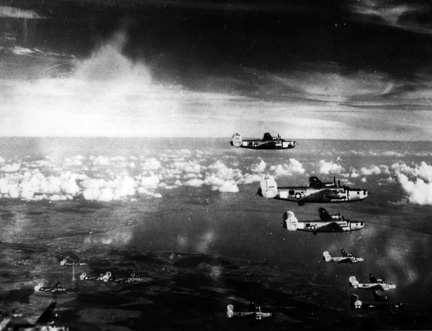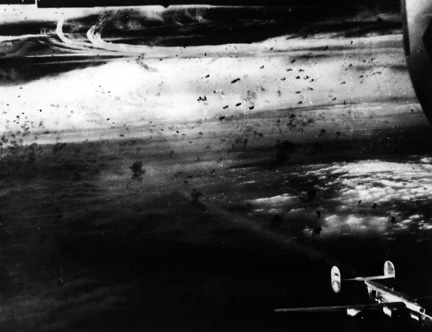|
Story of WW II Shoot Down and POW Experiences |
||||||||||
 |
 |
|||||||||
|
Unlucky 13, Shoot Down and Capture Mission 13/00 — 13 October 44 — Ostereichische Motor Hs — Vienna, Austria This mission would have made a double mission if we would have returned. It was Friday the 13th of October 1944, a day I will never forget. The target for the day was Vienna, Austria with maximum effort of 6 squadrons of 7 aircraft each to make a group effort of 42 airplanes. We had the number 2 place in the squadron which put us in front. But, on takeoff the left fuel cell in the wing funneled the fuel out as the cap was not secured properly, so we aborted and landed. The standby plane was all ready and waiting so we unloaded, taking our flak vests with us to the standby aircraft. After we boarded, we noted the plane had a set of vests aboard, but we kept all these plus the ones we wore. We laid the other set on the floor for extra safety from flak. When we returned to the squadron we took the seventh place in the flight, known as Tailend-Charley, and we were off to our target. The aircraft was named Our Gal serial number 44-41152, Model J. |
||||||||||
 |
||||||||||
|
to target, Vienna, 13 October 1944 |
||||||||||
 |
||||||||||
|
on 13 October 1944 from Capt. R. E. Smith’s ship during the time over the target at Vienna. Nose gunner, S/Sgt. J. C. Easier was hit and injured in the left arm by flack at the target. |
||||||||||
|
We had cloud cover under us most of the way, which helped in some ways, but we had to keep a sharp eye for fighters coming out of the clouds. As we came near the IP, the turning point to the target, the sky was clear over the target, which also gave the Jerrys a clear target. The flak was very heavy 88mm, 105mm and 155mm. Although we flew at different altitudes, 20,000 feet and up, we were flying at about 24,000 feet and there was so much flak that it rattled the aircraft continually. Whatever happened to number three of our squadron, we do not know, as the aircraft slid back and on bomb release dropped its bombs onto the number six aircraft. The explosion off our right wing was terrific. As I picked myself off the floor I put on my parachute.
After putting on my parachute, I noted the damage, a large hole in the right side of the aircraft just forward of where I was standing manning the waist gun. Also the number three engine was windmilling out of control and was sitting cocked in the cowling, which caused a lot of drag. About this same time, shells (155mm) went through the Bombay without exploding, leaving the fuel to soak the four of us in the rear with 100 octane fuel. We were sure that we had bought the end. Eddie-Joe put on his goggles and watched for a signal from the skipper while sitting in a spray of fuel. Next was a fire in number one engine and then on to number two engine. When the tail section started to melt, we got Lenny out of his turret and about the same time Eddie-Joe gave the signal to abandon the aircraft. We had opened the hatch earlier, just in case of an urgent bailout. We were ready with our parachutes on and checked and had agreed on the order we would go out. I was designated first to go out and dropped out. I free fell about 5,000 feet and pulled my parachute ring. The parachute snapped out and a buckle on the straps hit me in the mouth, breaking a tooth off at gum line. The few minutes that I was riding the parachute down I saw the rest of the crew down the line and, as I neared the ground, I saw farm workers running to about where I would land. Landing in a cornfield, I gathered my parachute up and stuck it into a corn shock and sat down to put on my shoes. When flying I wore heated shoes with flight boots to keep my feet warm. But just in case, I had wired a pair of shoes to a snap-ring on the seat ring of my harness. As I unwired my shoes and was putting them on, the field workers came. They ran by at first but then a fellow with a double barrel shotgun came and laid it on my nose. The language barrier was there and I thought this would be it. I got up and was given my parachute and boots to carry and marched off toward a small hamlet with old double barrel jabbing me in the back. It appeared that he was quite provoked at us because we were “terror-fligers.” Part way I met the bombardier assigned to our crew for this mission, Vern Drower. The uniformed military took us on into the village and I was glad to get rid of shotgun. End of Chapter 5 Go to Cover — Introduction — Table of Contents Chapter — 1 — 2 — 3 — 4 — 5 — 6 — 7 — 8 — 9 — 10 — 11 — 12 — 13 Or Go To Home - Contact Us - Cold War Hist. - 91st SRS Hist. - Stardust 40 Mission Story |
||||||||||